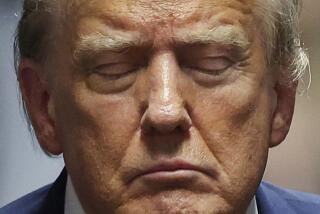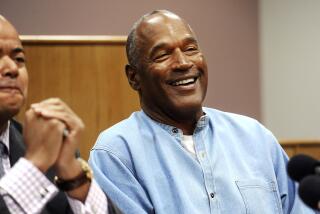Words Without Images Are Half the Story
For journalists who can’t squeeze into the O.J. Simpson courtroom, covering his testimony is time-traveling to the past, hearing his deep voice and sighs on speakers in off-courthouse audio rooms as if it were radio.
Radio is a powerful medium, as Franklin D. Roosevelt taught the country generations ago. Monday’s sounds of Simpson proved the point again as he labored to explain contradictory evidence and cuts on his hand.
We got a full dose of drama in our audio room when Simpson’s voice boomed his denial to another barrage of questions from attorney Dan Petrocelli accusing him of the murders of Nicole Brown Simpson and Ron Goldman. It was a reprise of the blasting finale Petrocelli used during Simpson’s first day of testimony Friday. At one point, Petrocelli said: “You confronted Nicole and you killed her, correct?” After a weekend to think and rest, Simpson’s denial was stronger than it had been in similar circumstances Friday: “No, Mr. Petrocelli. That’s totally, absolutely incorrect.”
Dramatic, maybe, but not the whole story. With radio, millions of Americans thrilled to the sound of Roosevelt’s voice without ever knowing how badly polio had disabled him.
*
There are 40 spaces for reporters in the courtroom. Some are there full time. Others share places. When it’s not their turn in court, they listen to the trial in audio rooms located in the Doubletree Hotel, near the courthouse, or in Camp O.J., where the television networks and stations have their facilities.
The Doubletree room, where I work, was almost empty until Simpson took the stand. It’s been packed ever since.
We can only imagine the sights of the courtroom, or hear about them later from colleagues inside. But we hear the questions and answers as clearly as they do. We hear Simpson’s deep breathing at tense moments.
We hear and we filter. The reporters in the audio rooms and the courtroom, by the very nature of their jobs, view what they see and hear through their own sensibilities, and organize it into news reports.
And yet in the high pressure, speed-at-all-cost world of daily journalism, during a fast-paced big story, they can be uncertain about what takes place before them.
An example of that was during the final moments of Petrocelli’s examination of Simpson on Monday, when he was bombarding him with accusatory questions.
The lawyer fired off his questions quickly, determined to deny Simpson time to think. Simpson, prepared, answered each accusatory question calmly and quickly. “Untrue. Untrue. That’s untrue.”
You didn’t have to be in the courtroom to sense the contempt in Petrocelli’s voice. “I have no further questions,” he said. From his tone, he might as well have called Simpson a liar.
The words tumbled out so fast the reporters in our audio room weren’t sure of the accuracy of their notes. Since transcripts are not available until hours after adjournment, the journalists gathered around and compared notes, finally reaching a consensus on what was said.
This happens at trials, where tape recorders are usually not allowed. With deadlines approaching and the boss on the phone, you don’t have time to wait for transcripts.
Nothing wrong with it at most trials. But not here, not at this trial.
*
Technically, this is a legal action brought by the relatives of Ron Goldman and Nicole Brown Simpson for damages due to wrongful death. But the stakes go far beyond the litigants.
Simpson’s criminal trial exposed deep racial divisions in the community as no trial has since those growing out of the Rodney King beating.
That makes the second trial bigger than just another wrongful death suit tried in the Santa Monica courthouse. The community, divided over the first trial, has a legitimate interest--beyond prurient curiosity--in watching the second installment.
Judge Hiroshi Fujisaki obviously doesn’t think so. Neither did the state judicial council, which in the wake of the first Simpson verdict limited televising trials, a move supported by many attorneys. They’d rather have the proceedings presented to the public through journalistic filters.
As one of the filters, I think that’s too limited. We describe, but it’s through our eyes. In these multimedia times, the reporters at the scene, equipped with only note pads and the power of observation, don’t have the credibility of a half century ago, when we were the sole source of information.
Nor should we be. If there had been television, rather than journalistic filters, the media could not have made the dying Franklin Roosevelt seem healthy.
More to Read
Sign up for Essential California
The most important California stories and recommendations in your inbox every morning.
You may occasionally receive promotional content from the Los Angeles Times.










